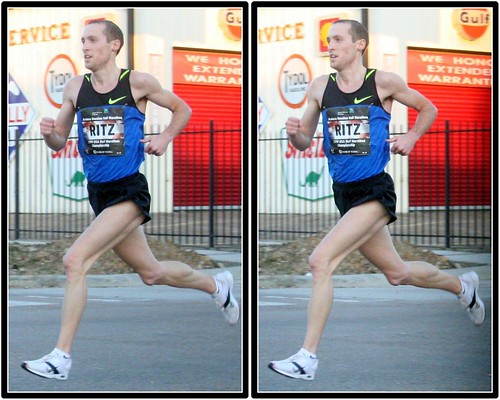I opened the New Yorker a couple of weeks ago to find a feature piece written by Jennifer Kahn, a friend of mine from college. The New Yorker has good taste. Jenn was a fellow physics undergraduate major, but at graduation decided to pursue a career in science journalism. This seems much more challenging than physics; there is no clear career path, supporting oneself financially is a constant struggle, and success is often ill-defined and elusive. But Jenn has succeeded. She is a contributing editor at Wired and a teaching fellow at the Berkeley Graduate School of Journalism. She has published in a wide range of magazines, and has had four articles selected for the annual “Best American Science Writing” series. This is her second feature article for the New Yorker (her previous was on the 9/11 syndrome).
Her article is on Dathan Ritzenhein, a marathoner trying to recapture his glory days. He is being coached by Alberto Salazar, “regarded by many as the best American marathoner ever.” The trick is that Salazar is trying to reinvent the way Ritzenhein runs. And, most interestingly, the approach is to apply science and technology, rather than simply blunt training and fitness, to perfect the athlete. Jenn tells us:
The fastest finishers had a higher thigh drive, for one thing; at its apex, their femur bone was almost parallel to the ground, like the front legs of a bounding deer. They also slapped the ground so quickly with their forefoot that the contact seemed almost incidental. According to Walker, the short slap transfers force more efficiently, shooting it from the ground forward into the pelvis, rather than allowing it to dissipate in the flex of the foot. The effect, Walker says, is like “a pogo stick with a stiff spring.” He explained, “You want the chain of force to travel from the ground through the body with minimal energy loss. That’s what it means to run efficiently.”
I’m not sure any equations are involved, but the basic idea of applying science directly to biomechanics makes sense. The novelty is that it’s not just making a slipperier swim suit or a faster sneaker, but rather it’s an attempt to engineer a whole new way for the body to move.
The story came out the week of the New York Marathon. We now have the benefit of hindsight. Ritzenhein placed eighth, over four minutes behind the top finishers (but still at an unbelievable 2:12:33; I couldn’t keep up for even half a mile, much less all 26+). I guess physics can only do so much.





 ShareThis
ShareThis